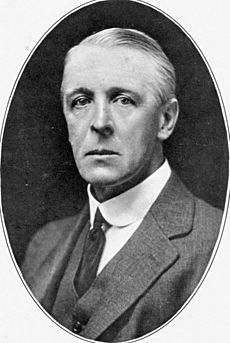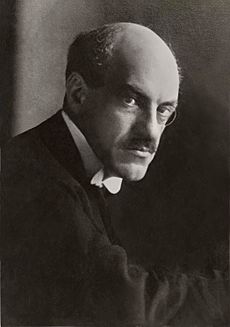Montagu–Chelmsford Reforms facts for kids
The Montagu–Chelmsford Reforms, also known as the Mont–Ford Reforms, were important changes made by the British government in British India. These reforms aimed to slowly introduce ways for Indians to govern themselves.
The reforms are named after Edwin Montagu, who was the top British official for India (called the Secretary of State for India) from 1917 to 1922, and Lord Chelmsford, who was the Viceroy of India (the British ruler in India) between 1916 and 1921.
These ideas were written down in the Montagu-Chelmsford Report in 1918. This report then became the basis for the Government of India Act 1919.
Many Indian leaders felt these changes didn't go far enough. They wanted more control for Indians. However, some British politicians thought the reforms gave too much power away.
Two main changes from these reforms were:
- The main law-making body, the Imperial Legislative Council, was split into two parts: the Central Legislative Assembly and the Council of State.
- Provinces (like states) started using a system called dyarchy, which meant a "dual government."
Contents
Why These Reforms Happened
Edwin Montagu became the Secretary of State for India in June 1917. He wanted to help India move towards self-government. He suggested that the British should work towards giving Indians more freedom to run their own country.
Another important British leader, Lord Curzon, agreed but wanted to make sure it was clear that India would still be a part of the British Empire. So, the plan was to slowly increase Indian involvement in running the country and develop self-governing groups.
What the Reforms Did
In late 1917, Edwin Montagu traveled to India. He met with Lord Chelmsford, the Viceroy, and many Indian leaders. They talked about how to give India some limited self-government and protect the rights of smaller groups.
Montagu then wrote a report with help from others, including Bhupendra Nath Bose. This report was approved and became the Government of India Act of 1919. These changes were the most the British were willing to offer at that time.
The right to vote was expanded, and the central and provincial law-making councils got more power. However, the Viceroy in India still answered only to the government in London.
Changes in the Provinces
The biggest changes happened in the provinces. The provincial law-making councils now had many more elected Indian members.
A new system called "dyarchy" was introduced in the provinces. This meant that government departments were split into two groups:
- Transferred Subjects: These were areas like health, education, and local self-government. They were managed by Indian ministers who were responsible to the elected provincial council.
- Reserved Subjects: These were important areas like finance, law and order, and the police. They were kept under the control of British officials appointed by the Governor. These officials were responsible to the Governor, not to the elected council.
This system was put in place in many provinces, including Bengal, Madras, Bombay, and Punjab.
In 1921, another change happened: elected local councils were set up in rural areas. Also, city councils became more democratic and had more Indian members.
Key Rules of the Reforms
Here are some of the main rules from the Montagu-Chelmsford Reforms:
- The Secretary of State in Britain would still be in charge of India's government.
- The main law-making body in India, the Imperial Legislative Council, would have two parts: the Council of State and the Central Legislative Assembly.
- This Imperial Legislative Council could make laws for all of India.
- The Governor General (another name for the Viceroy) could call meetings, stop them, or end them. He could also make special orders.
- Out of eight members in the Viceroy's Executive Council (his main advisors), three would be Indians.
- Provincial councils would also have two parts (bicameral).
- The "dyarchy" system in the provinces split subjects into "reserved" (like finance, police) and "transferred" (like public health, education).
- People could now vote directly, and voting rights were extended to more communities.
- A Council of Princes was created with 108 members. This allowed Indian princes to discuss important matters, but it didn't have real power.
Looking Back at the Reforms
The Montagu-Chelmsford Report said that the reforms should be reviewed after 10 years. So, a group led by Sir John Simon (called the Simon Commission) reviewed them. They suggested even more changes to the way India was governed.
Three important meetings, called "round table conferences," were held in London in 1930, 1931, and 1932. Leaders from India, including Mahatma Gandhi, attended these meetings.
One big disagreement was about "separate electorates" for different communities. The Indian National Congress (a major Indian political party) was against this, but the British kept them in place.
These discussions led to a new law, the Government of India Act 1935. This act continued the journey towards self-government in India, which had started with the Montagu-Chelmsford Reforms.
|



